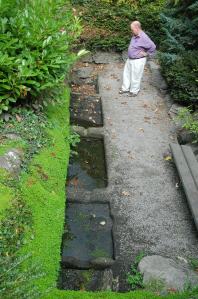Last year I put up a page about Calverley Town Wells which attracted some readers’ comments. One of these, from M. Chappellow, gave the history of the Calverley Spa Well.
My family have lived in Calverley for generations ,
The chalybeate well or waters were first discovered around 1830 whilst digging a coal pit by the Sutcliffe family who dug numerous coal pits in the Shell Lane area of Calverley , there was a bit of a dispute as the Sutcliffes wanted a cut out of it as they found it but so did the Thornhills who owned the land as well as the farmer J Thornton who rented the land then as the actual source of the water ran under Glebe land which is where roughly the Calverley arms hotel is which was then owned by the Vicar or church they wanted a cut out of any money generated ,the story goes that after digging 37 yards into the hillside they came upon a water source that tasted like crab apples .
After about 6 months someone drank the water & died that was the end of that ,
All that’s left now is a damp patch in the middle of the field ,
There was also another well in the next field up just in the dip on Farsley Lane where the millennium way foot path is think that one was called Coates well .
We used to have an old map with the springs & wells of the village.
At the time I was a little unsure of the dating here but I’ve since been doing some more research on the subject and I find that M. Chappellow is right in what s/he says. The confusion is entirely my fault. I had remembered reading an account of a visit to Calverley in The Spas of England by Augustus Bozzi Granville. However I had misread the publication date and thought that Granville’s visit was too early for the date given. It’s not: the book was published in 1841 and so fits in well with the account given by M. Chappellow.
According to Granville, the water tasted like ‘an unripe crab apple – it puckers up the membranes of the mouth’. (This reminds me that there’s a Crab Tree Well at South Crosland near Huddersfield. I’d always assumed that the name derived from a nearby fruit tree. Perhaps it actually got its name from the taste of the water.) Granville was also of the opinion the Calverley would ‘never rise to the rank of a fashionable watering place’…
I also wonder if the spring which formed the abortive spa was known at one time as the Farewell as the Calverley TitheAward map (which can be searched electronically through the Tracks in Time website) has the field names Farewell Ing and Farewell Close in the area where the chalybeate well is shown on the modern map. Coates Well Close is a little further to the south.
These were not the only wells in Calverley. In his 1988 booklet The History of Town Wells and the Green E. W. Garnett mentions wells in the following locations:
Woodhall Road
West End Road
Above Foxholes
In Calverley Woods
At the bottom of Thornhill Street (often referred to as Well Head or Draw Well)
Of the ones mentioned in the list, I think only Tomblin Well (or Tombling Well) in Calverley Woods now still survives. There is however a large trough at the point where Towngate divides into Calverley and Rodley Lanes (SE 211 367). A little further from the centre of the village on Woodhall Road (at SE 201 354, south of Woodhall itself) there is a recess which once held a pump, but all traces of the pump itself has gone.
Perhaps there are other traces of these old sources of water still to be found in the Calverley district…


